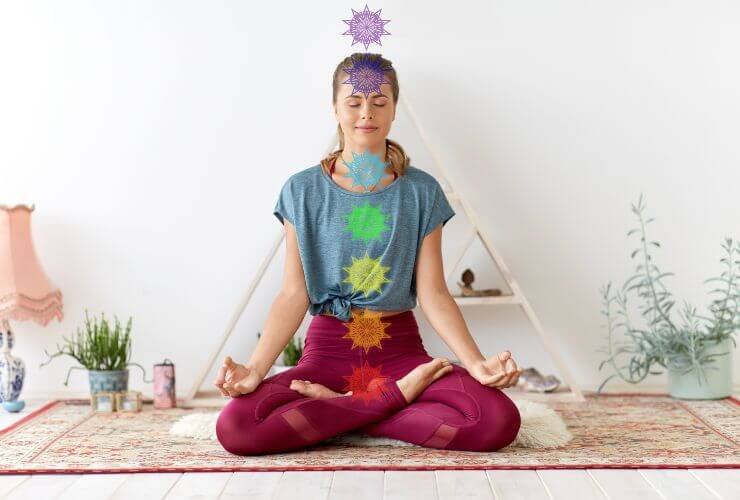Mindfulness meditation is a mental training practice that teaches individuals to slow down racing thoughts, let go of negativity, and calm both the mind and body.
It is a type of meditation that involves focusing on being intensely aware of what one is sensing and feeling in the moment without interpretation or judgment.
Practicing mindfulness involves various techniques such as breathing methods, guided imagery, and other practices to relax the body and mind and help reduce stress.
The term “meditation” refers to a variety of practices that focus on mind and body integration and are used to calm the mind and enhance overall well-being.
Mindfulness meditation is one of the most popular forms of meditation, with its roots in Buddhist teachings.
It has been practiced for thousands of years, often as part of a spiritual practice, and has gained popularity in recent years due to its potential benefits for mental and physical health.
Research has shown that mindfulness meditation can help reduce stress, improve focus and attention, and promote emotional regulation.
In this article, we will explore what mindfulness meditation is, its benefits, how to practice it, and some tips for beginners.
Whether you are new to meditation or looking to deepen your practice, this article will provide you with the information you need to get started with mindfulness meditation.
Understanding Mindfulness Meditation
Origins and History
Mindfulness meditation is a practice that has roots in ancient traditions, including Buddhism and Hinduism.
The practice has been around for thousands of years and is still relevant today.
It was introduced to the Western world in the 1970s by Jon Kabat-Zinn, who developed the Mindfulness-Based Stress Reduction (MBSR) program.
Since then, it has gained popularity and has been studied extensively by researchers.
Principles and Concepts
Mindfulness meditation is a mental training practice that teaches individuals to focus their attention on the present moment.
It involves paying attention to one’s thoughts, feelings, and bodily sensations without judgment.
The practice aims to cultivate a sense of calmness and clarity, while reducing stress and anxiety.
The following are some key principles and concepts of mindfulness meditation:
- Non-judgment: Mindfulness meditation involves observing one’s thoughts and feelings without judgment. This means letting go of any preconceived notions or biases and simply observing what is happening in the present moment.
- Acceptance: Practitioners of mindfulness meditation learn to accept their thoughts and feelings, no matter how uncomfortable they may be. This helps to reduce stress and anxiety and promotes a sense of well-being.
- Self-awareness: Mindfulness meditation helps individuals develop self-awareness by paying attention to their thoughts, feelings, and bodily sensations. This can help individuals better understand themselves and their reactions to different situations.
- Focus: Mindfulness meditation involves focusing one’s attention on the present moment. This can help individuals develop better concentration and focus, which can be helpful in many areas of life.
Overall, mindfulness meditation is a powerful tool that can help individuals reduce stress and anxiety, improve their overall well-being, and develop a greater sense of self-awareness.
By practicing mindfulness meditation regularly, individuals can develop a greater sense of calmness and clarity, which can help them navigate life’s challenges with greater ease.
Benefits of Mindfulness Meditation
Physical Health Benefits
Mindfulness Meditation has been linked to several physical health benefits. Some of the benefits are:
- Reduced blood pressure
- Lowered cholesterol levels
- Improved sleep quality
- Reduced chronic pain
- Boosted immune system
- Reduced inflammation
Studies have shown that mindfulness meditation can help in reducing the risk of heart disease, stroke, and other chronic illnesses.
Mental Health Benefits
Mindfulness Meditation has been shown to have several mental health benefits.
Some of the benefits are:
- Reduced stress and anxiety
- Improved focus and attention
- Increased emotional regulation
- Reduced symptoms of depression
- Improved cognitive flexibility
- Increased self-awareness
Studies have shown that mindfulness meditation can help in reducing symptoms of anxiety, depression, and stress-related disorders.
Emotional Health Benefits
Mindfulness Meditation has been linked to several emotional health benefits.
Some of the benefits are:
- Increased self-compassion
- Improved relationships
- Increased empathy and compassion
- Reduced emotional reactivity
- Increased resilience
- Reduced symptoms of PTSD
Studies have shown that mindfulness meditation can help in improving emotional regulation, increasing resilience, and reducing symptoms of PTSD.
Overall, mindfulness meditation has been shown to have several physical, mental, and emotional health benefits.
It can be a valuable tool for improving overall well-being and quality of life.
Practicing Mindfulness Meditation
Basic Techniques
Basic mindfulness meditation techniques involve finding a quiet place where you can sit comfortably and focus on your breath.
Here are some steps to get started:
- Find a quiet place where you won’t be disturbed.
- Sit comfortably with your back straight and your feet on the ground.
- Close your eyes and take a few deep breaths.
- Focus your attention on your breath as it enters and leaves your body.
- When your mind wanders, gently bring your attention back to your breath.
It’s important to remember that the goal of mindfulness meditation is not to stop your thoughts or clear your mind.
Instead, it’s about learning to observe your thoughts without judgment and to bring your attention back to your breath when your mind wanders.
Advanced Techniques
Once you’ve mastered the basic techniques of mindfulness meditation, you can explore more advanced practices.
Here are a few examples:
- Body scan meditation: This involves slowly scanning your body from head to toe, paying attention to any sensations you feel along the way.
- Loving-kindness meditation: This involves directing positive thoughts and feelings towards yourself and others.
- Walking meditation: This involves walking slowly and mindfully, paying attention to the sensations in your body as you move.
Remember, there is no right or wrong way to practice mindfulness meditation.
The key is to find a technique that works for you and to make it a regular part of your routine.
With practice, you can learn to cultivate a sense of calm and inner peace that can help you navigate life’s challenges with greater ease and resilience.
Common Challenges and Solutions
While mindfulness meditation can be a powerful tool for reducing stress and improving overall well-being, it is not always easy to practice.
Here are some common challenges that people may encounter when trying to incorporate mindfulness into their daily lives, along with some potential solutions.
Challenge: Distractions
One of the biggest challenges in mindfulness meditation is dealing with distractions.
Whether it’s external noises or internal thoughts, it can be difficult to stay focused on the present moment.
Solution: Acknowledge and Refocus
When distractions arise, it can be helpful to simply acknowledge them and then refocus on the present moment.
This may involve taking a few deep breaths or using a visualization technique to help bring the mind back to the present.
Challenge: Physical Discomfort
Sitting still for extended periods of time can be uncomfortable, especially for those who are not used to it.
This can lead to physical discomfort and make it difficult to focus on the meditation practice.
Solution: Adjust Posture or Try a Different Position
It may be helpful to adjust posture or try a different position to alleviate discomfort.
For example, sitting on a cushion or using a chair with good back support can help reduce strain on the back and hips.
Challenge: Time Constraints
Many people struggle to find the time to practice mindfulness meditation regularly.
This can make it difficult to establish a consistent practice.
Solution: Start Small and Build Up
Starting with just a few minutes of meditation each day and gradually increasing the time can help make the practice more manageable.
It may also be helpful to schedule meditation time into the daily routine to ensure that it does not get overlooked.
Challenge: Lack of Motivation
Finally, some people may struggle with maintaining motivation to practice mindfulness meditation over time.
This can make it difficult to establish a consistent practice.
Solution: Find a Support System
Finding a support system, such as a meditation group or a friend who is also interested in mindfulness, can help provide motivation and accountability.
It may also be helpful to remind oneself of the benefits of mindfulness meditation and how it can improve overall well-being.
Mindfulness Meditation and Modern Science
Mindfulness meditation, a practice that has been around for thousands of years, has gained increasing popularity in modern times.
This rise in popularity has led to a significant amount of scientific research on the benefits of mindfulness meditation.
Research has shown that mindfulness meditation can be an effective tool for reducing stress and improving overall emotional health.
A systematic review of more than 20 randomized controlled trials in 2011 demonstrated improvements in overall mental health, as well as its benefit for reducing the risk of relapse from depression.
In addition to its benefits for emotional health, mindfulness meditation has also been shown to have physical health benefits.
A study published in the Journal of the American Medical Association found that mindfulness meditation can help lower blood pressure and reduce symptoms of anxiety and depression.
Neuroscience research has also shown that mindfulness meditation can have a positive impact on the brain.
Studies have found that mindfulness meditation can increase activity in regions of the brain associated with emotional regulation and attention.
This increased brain activity can lead to improved focus, decreased stress, and better emotional regulation.
Overall, the scientific research on mindfulness meditation suggests that it can be a valuable tool for improving both mental and physical health.
As more research is conducted, it is likely that even more benefits of mindfulness meditation will be discovered.
Conclusion
Mindfulness meditation is a mental training practice that has been used for thousands of years to improve overall well-being.
It involves focusing one’s awareness on the present moment, letting go of negativity, and calming both the mind and body.
Research has shown that mindfulness meditation can be a research-proven way to reduce stress and improve mental health.
It has been found to change the brain in depressed patients and can help people become more self-aware.
Practicing mindfulness meditation can improve general well-being and enhance overall quality of life.
It is a simple yet powerful technique that can be easily incorporated into daily life.
While mindfulness meditation may not be a cure-all, it is a valuable tool that can help individuals manage stress and improve their mental and physical health.
With regular practice, anyone can learn to cultivate a sense of inner peace and calm in their daily lives.
Frequently Asked Questions
Why is mindfulness important?
Mindfulness is important because it helps to reduce stress and anxiety, improve focus and concentration, and increase overall well-being. By practicing mindfulness, individuals can learn to be more present in the moment, which can lead to a greater sense of peace and contentment.
What are the 5 steps of mindfulness?
The 5 steps of mindfulness are:
- Set aside time for mindfulness practice.
- Find a quiet and comfortable place to practice.
- Focus on your breath and bring your attention to the present moment.
- Notice when your mind wanders and gently bring your attention back to your breath.
- Practice regularly to develop mindfulness as a habit.
How do you do mindfulness meditation?
To do mindfulness meditation, find a quiet and comfortable place to sit. Close your eyes and focus on your breath. When your mind wanders, gently bring your attention back to your breath. Practice for a few minutes each day and gradually increase the amount of time you spend meditating.
What is the difference between meditation and mindfulness meditation?
Meditation can refer to any practice that involves focusing the mind, while mindfulness meditation specifically involves focusing the mind on the present moment and being fully aware of one’s thoughts, feelings, and surroundings.
What are some examples of mindfulness in everyday life?
Examples of mindfulness in everyday life include:
- Paying attention to the taste and texture of food while eating.
- Noticing the sensations of your body while walking.
- Listening fully to another person during a conversation.
- Being fully present while engaging in a hobby or activity.
What are some mindfulness exercises for anxiety?
Some mindfulness exercises for anxiety include:
- Deep breathing exercises
- Body scan meditation
- Progressive muscle relaxation
- Mindful walking
- Visualization exercises
Overall, mindfulness meditation is a powerful tool for reducing stress and anxiety, improving focus and concentration, and increasing overall well-being.
By practicing mindfulness regularly, individuals can learn to be more present in the moment and develop greater self-awareness.






Pingback: The Healing Power of Yoga: Benefits of Yoga For Mental Health - YOGMAY
Pingback: What is Yoga Nidra? A Deep Dive into the Yogic Sleep - YOGMAY
Pingback: What is Meditation? Types and Benefits Explained - YOGMAY
Pingback: How to Become a Yoga Instructor: A Step-by-Step Guide
Pingback: How to Clean a Yoga Mat: A Step-by-Step Guide - YOGMAY